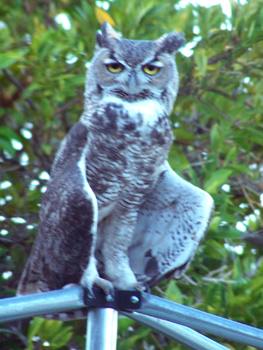|
|
THE GREAT HORNED OWL
For anyone who has ever slept in the desert--in a bedroom, a tent, or out on
the open ground--one of the most pleasant sounds in the night is the call of an
owl. In Anza-Borrego, the owl most often heard is the Great-Horned Owl,
Bubo virginianus.
The Great-Horned Owl is considered large, ranging in height from 18 inches to 25
inches with a wingspan of up to 55 inches; the female Great-Horned Owl is even
larger.
But what really distinguishes the Great-Horned Owl from other species its size
are its wide-spaced "horns," or tufts. Actually, these feathery tufts are not
used for hearing; the real ears are on the sides of the head, under the feathers
of the facial disk. |
 |
If you are new to owl identification, you might confuse the Great-Horned Owl
with the Long-Eared Owl, commonly seen at the Tamarisk Grove Campground. The
difference is the Long-Eared Owl's tufts are closer together and it is much
smaller than the Great-Horned Owl.
At night, if you hear two Great-Horned Owls hooting (read courting), the call of
the female is a slightly higher pitch than the male. The hooting resembles the
dots and dashes of Morse Code: HOOT! Hu-hu-hu HOO! When the courting is
successful, the birds move closer together and the hooting sequences are more
rapid as well.
Great-Horned Owls nest in the abandoned nests of large birds like ravens and
hawks. They sometimes lay their eggs on cliff ledges without benefit of a nest.
One of their secrets seems to be that they nest earlier than other birds, in
February or even December or January. They have been known to nest from Borrego
Springs north all the way to Lower Willows, as far east as Palm Wash at the foot
of Traveler's Peak in the Santa Rosa Mountains, and at Banner, the North Pinyon
Mountains, and the Canebrake area to the west and south.
As reported in the last issue of The Sand Paper, a Great-Horned Owl has been
roosting in native palm trees at a Borrego Springs residence since last May was
still there in late September--only now, at times, there are two. The pair is
especially vocal before sunrise when they hoot back and forth to each other from
various perches including telephone
poles and rooftops. During midday when one of the owls roosts high in the palm
tree, neighborhood songbirds and ravens take turns making agitated calls and
sometimes dive-bomb the owl, trying to drive it from its perch. They recognize
the owl as a threat, and rightly so, since it feeds on a variety of animals
including rabbits, rodents, and birds--large and small.
The Great-Horned Owl is the most widespread owl in North America and is found in
diverse habitats from cold northern forests to hot southern deserts. Since owls
are warm-blooded animals, they must have mechanisms to thermo-regulate in
sub-zero winters and 100-degree summers. In the desert, they keep cool on
extremely hot days by panting like dogs and by drooping their wings so that air
can circulate to areas beneath.
In addition, they seek out cool, shady roosting spots during the day, locations
that are cooler than the average open area--just like Borregans do.
And HOO wouldn't?
|
|

|
|

|